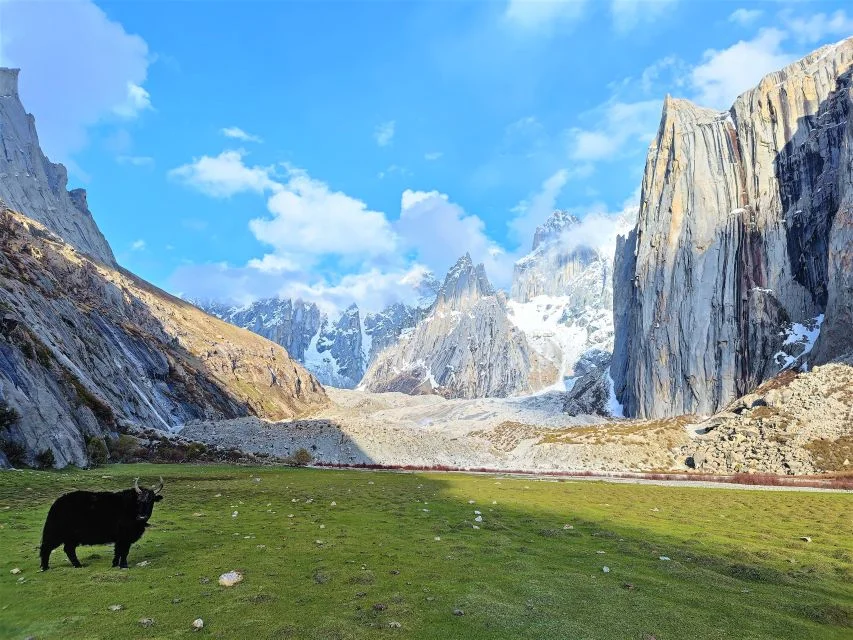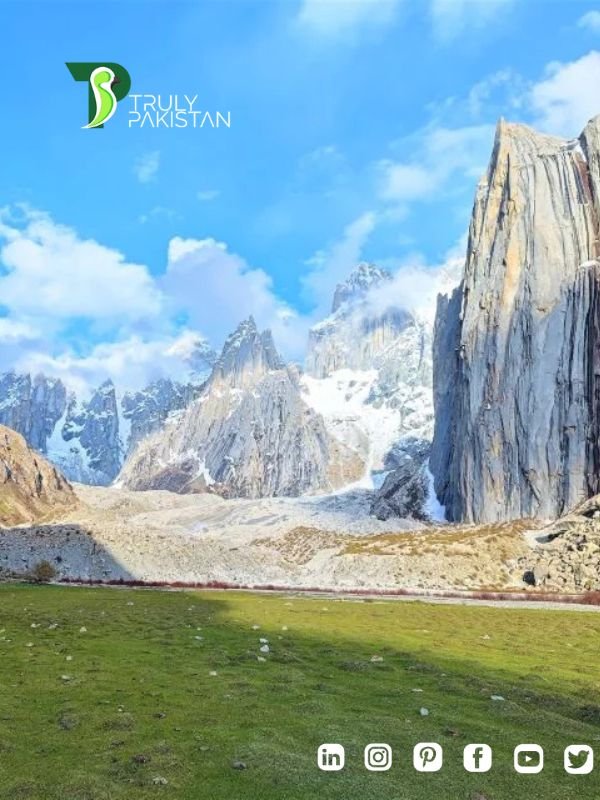Nangma Valley Pakistan: The Yosemite of the Karakoram — Ultimate Trekking & Travel Guide (2025)
If you’re a trekker, climber, or nature photographer dreaming of high alpine meadows, granite towers, and untouched wilderness, Nangma Valley, Pakistan should be on your list. Known as the “Yosemite of Pakistan,” Nangma is a pristine valley tucked deep in the heart of Gilgit-Baltistan’s Karakoram Range, offering stunning views, challenging climbs, and some of the most peaceful trekking trails in the country.
As someone who’s explored and guided across the northern regions of Pakistan, I can confidently say Nangma isn’t just another scenic valley — it’s a spiritual experience for outdoor lovers. In this comprehensive guide, I’ll walk you through everything from how to reach it, to where to camp, what gear you’ll need, and how to connect with the Balti community along the way.
Welcome to Nangma Valley Pakistan’s Yosemite of the East
Nangma Valley lies in the Ghanche District of Baltistan, accessed from the village of Kanday near the famed Hushe Valley. The valley’s claim to fame? Towering granite spires like Amin Brakk and Zahid Peak that rise dramatically out of lush green meadows, forming one of the most photogenic climbing destinations in the world.
This is one of those rare places where you’ll likely see more eagles than tourists. The valley remains off the radar for most, but has been quietly earning global recognition — featured by the New York Times and TIME Magazine as one of the “World’s Greatest Places.”
Why Nangma Valley Deserves a Spot on Your Trekking Bucket List
- Towering granite spires (Amin Brakk is nicknamed “Pakistan’s El Capitan”)
- Alpine meadows perfect for camping, stargazing, and quiet reflection
- A globally underrated rock climbing and mountaineering paradise
- Minimal crowds, crystal-clear skies, and raw natural beauty
- A chance to engage with Balti culture in remote villages like Kanday
If you’ve already been to Fairy Meadows or Swat Valley and are looking for something more remote and immersive — this is it.
Fast Facts – Elevation, Weather, and When to Go
- Location: Kanday village, Ghanche District, Gilgit-Baltistan
- Elevation: Campsites between 3,600m to 4,300m
- Trek Duration: 3 to 10 days, depending on route
- Best Season: Mid-June to early September
- Camping: Wilderness camping only; no commercial lodges inside valley
Pro tip: July is the sweet spot — wildflowers are in full bloom, the weather is stable, and trails are dry enough for moderate trekking without snow gear.
How to Reach Nangma Valley from Islamabad or Skardu
Reaching Nangma Valley requires getting to Skardu first, followed by a road journey to Kanday village, the official gateway to the valley. Here’s a simplified breakdown:
- Islamabad to Skardu (Option 1 – By Air): Daily flights via PIA take 45–50 minutes. Subject to weather.
- Islamabad to Skardu (Option 2 – By Road): A two-day drive via the Karakoram Highway and Jaglot-Skardu road. Possible year-round but long and tiring.
- Skardu to Kanday: 5–6 hours by jeep. Most trekkers use a 4×4 hire via Khaplu or Hushe route. Road condition varies by season.
Permit Requirements: Pakistani nationals do not need permits. Foreigners should consult local tour operators in Skardu or the Gilgit-Baltistan Tourism Office for any updated NOC or trekking clearance policies, especially for overnight camping.
Nangma Valley Trekking Itinerary – Day-by-Day Breakdown
The beauty of Nangma is its flexibility. Whether you have just three days or a full week, you can explore key areas without technical climbing. Below are a few itinerary options depending on your fitness, interest, and available time.
Option 1: 3-Day Trek (Short Format)
- Day 1: Skardu to Kanday, start trek to base camp (Zahid or Mingulo Broq)
- Day 2: Explore Amin Brakk and surrounding alpine meadows
- Day 3: Return to Kanday and drive back to Skardu
Option 2: 5-Day Trek (Balanced)
- Day 1: Skardu to Kanday, overnight stay or short walk toward valley
- Day 2: Trek to Zahid Base Camp (around 4 hours, gentle incline)
- Day 3: Hike to Amin Brakk view ridge or continue to Mingulo Broq
- Day 4: Return to Zahid Base or Kanday depending on progress
- Day 5: Return to Skardu
Option 3: 7–10 Day Exploration Trek (Extended)
- Day 1–2: Skardu arrival, gear check, acclimatization
- Day 3: Drive to Kanday and begin trekking
- Day 4–5: Establish camp at Zahid or Mingulo Broq, optional side treks
- Day 6–8: Push to K6 Base Camp or explore side ridges toward Amin Brakk north face
- Day 9–10: Descend to Kanday and return to Skardu
Important: Treks beyond Zahid Base Camp may require experienced guides and prior mountain knowledge. While the lower valley trails are manageable for beginners, going deeper into the range means higher altitudes and glacier access points.
What to Pack for the Nangma Valley Trek
Nangma Valley might not involve technical mountaineering for most trekkers, but it does demand solid preparation. Whether you’re on a short trek or a multi-day exploration, proper gear is essential for safety and comfort.
Essential Clothing
- Moisture-wicking base layers (2–3 pairs)
- Insulating mid-layers (fleece or down)
- Waterproof outer shell (jacket and pants)
- Thermal gloves, cap, and neck warmer
- Sturdy hiking boots (broken-in)
Camping & Trekking Gear
- Sleeping bag rated for -5°C or colder
- Compact tent with groundsheet
- Headlamp, spare batteries
- Trekking poles (especially useful on descent)
- Water filter or purification tablets
- Basic medical kit (include altitude sickness meds)
If you’re joining a guided trek, most essentials may be provided. Independent trekkers should bring everything themselves, especially food and water provisions, as there are no shops once the trek begins.
Culture and Community: The Balti Way of Life
Nangma Valley is not just about towering granite peaks — it’s also about the people who call these remote valleys home. The village of Kanday is inhabited by Balti families known for their resilience, warmth, and deep-rooted hospitality. If you’re respectful and curious, you’re likely to be invited for a cup of salted butter tea or freshly baked barley roti.
Etiquette Tips:
- Always ask before photographing locals, especially women or children
- Dress modestly even when trekking
- Learn a few words of Balti or Urdu (e.g., “Shukriya” means thank you)
- Bring useful gifts like school supplies or solar lights, not sweets or money
Staying in local guesthouses at the trek’s start or end can enrich your experience and directly support the community.
Camping and Accommodation in Nangma Valley
There are no commercial hotels or huts inside the Nangma Valley trek route. All visitors stay in tents, either in designated camping clearings near Zahid Base Camp or along the riverside meadows of Mingulo Broq.
Kanday village does have some basic family-run guesthouses where you can rest before or after your trek. Some also offer porters, guides, and simple meals. Make sure to book in advance if you’re traveling during July or August, the peak trekking months.
Safety and Environmental Responsibility
Nangma is still untouched — help keep it that way.
- Use reusable water bottles and avoid plastic packaging
- Never leave trash behind, even biodegradable waste
- Camp at established sites rather than clearing new areas
- Respect seasonal wildlife and avoid feeding animals
Travelers should carry a map, inform someone in Skardu of their planned route, and avoid trekking solo deep into the valley without experience. Mobile signals disappear after Kanday, so satellite devices are advisable for longer treks.
Top Highlights and Things to Do in Nangma Valley
Whether you’re an alpine photographer, climber, or slow traveler, Nangma Valley offers raw natural beauty with minimal crowds. Some of the best highlights include:
- Amin Brakk: A 5,850m granite spire often referred to as Pakistan’s El Capitan. Ideal for climbers and serious photographers.
- Zahid Base Camp: The most popular camping zone, surrounded by granite walls and alpine meadows.
- Mingulo Broq: A higher camp spot with breathtaking views and wildflower meadows during July.
- Stargazing: With no light pollution, Nangma offers crystal-clear night skies for astrophotography.
- Rock Climbing: For professionals, the valley offers unclimbed and classic vertical routes. This is a high-risk, niche activity.
Frequently Asked Questions About Nangma Valley
Is a permit required to trek Nangma Valley?
For Pakistani nationals, no. Foreigners may require a NOC or permit depending on route and overnight camping plans. Always confirm in Skardu.
What is the best time to visit Nangma Valley?
June to early September is ideal. July is best for stable weather, clear skies, and meadows in bloom. Avoid October onward due to snow risk.
Is Nangma Valley safe for solo trekking?
Lower sections are manageable, but deeper treks to K6 Base or beyond should not be done solo. Trek with a guide or in a group for safety.
How difficult is the Nangma Valley trek?
Moderate for experienced hikers. Elevation is high but trails are non-technical up to Zahid Base and Mingulo Broq.
Are there local guides or porters available?
Yes. Kanday village offers experienced local porters and guides who know the terrain and weather patterns. Hiring locally supports the community.
What should I do in case of emergency?
There is no cellular network inside the valley. Carry a satellite phone or SPOT device. Inform someone in Skardu of your plan and return date.
Nearby Treks and Alternative Destinations
If you’re in the region, consider pairing Nangma Valley with:
- Hushe Valley – Trailhead for Gondogoro La and Masherbrum Base Camp.
- Fairy Meadows – More commercial but visually stunning near Nanga Parbat.
- Machulo La – Short, scenic trek with views of five 8,000m peaks.
References
- TIME – World’s Greatest Places: Nangma Valley
- New York Times – 52 Places to Love in 2021
- Lonely Planet – Nangma Valley Overview
- Khyber Pakhtunkhwa Tourism Department
Published: July 30, 2025
Author: ZunNurain Khalid



2 thoughts on “Nangma Valley Pakistan: The Yosemite of the Karakoram”